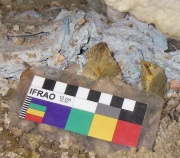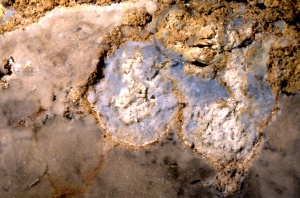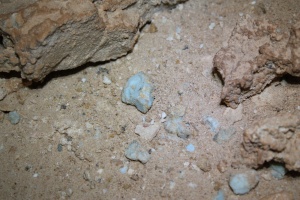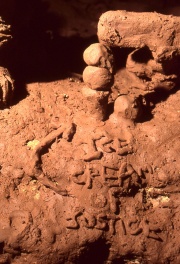Clays (Inventory)
From LagWiki
(Created page with '==Endellite== {{:Clays (Inventory)/Endellite}} {{clear}} ==Montmorillonite== {{:Clays (Inventory)/Montmorillonite}} {{clear}} ==Massive Bank== {{:Clays (Inventory)/Massive Bank???')
Newer edit →
Revision as of 22:14, 21 April 2011
Contents |
Endellite
The Endellite field of the Clays section should list stations where endellite is found.
Endellite is an aluminosilicate clay mineral which has been transformed by sulphuric acid from montmorillonite. Geologists usually know it as "hydrated halloysite"; but, speleologists still use the term "endellite". It is often found associated with montmorillonite. It is usually bluish in color but the color can range from white to deep blue or green. It is waxy and looks something like candle wax or soap. It can appear under breakdown or scattered in sediments. Look for it anywhere clays may accumulate.
See also
References
- Palmer, Arthur N. (2007) Cave Geology CAVE BOOKS, Dayton, OH p 119 ISBN-13: 978-0-939748-66-2, ISBN-10: 0-939748-66-5
- Hill, Carol; Paolo Forti (1997) Cave Minerals of the World (Second Edition ed.) National Speleological Society pp 177, 181-182 ISBN: 1-879961-07-5
Endellite, Clays
Montmorillonite
Clays (Inventory)/Montmorillonite
Massive Bank
The Massive Bank field of the Clays section should be used to record stations that exhibit a massive amount of clay in a single location.
In the Guadalupes, such massive banks of clay are usually red in color; but, they could be a variety of colors. Massive clay banks differ from corrosion residues. Where corrosion residues were concentrated when the limestone was dissolved and left them behind, massive clay banks are original concentrations in the bedrock. Similarly [[Clays (Inventory)/Residual red Clay|residual red clays are concentrated from dissolution and not original masses. This distinction may be difficult to discern accurately.
Massive clay banks are most often found associated with the backreef.
See also
Residual red clay
The Residual red clay field of the Clays section should be used to record stations that exhibit residual red clay.
Red clay is probably the most common clay found in the Guadalupes. It can appear as both a massive bank or a residue. This field should be used to record occurances of the residual variety.
Residual red clays are similar to corrosion residues. They both form by residues left behind from dissolution of the original bedrock. The residual red clays are made up of clay particles where the corrosion residues are usually somewhat larger particles. This distinction may be difficult to discern accurately in the cave.
Residual red clays are most often found associated with the backreef.
See also




